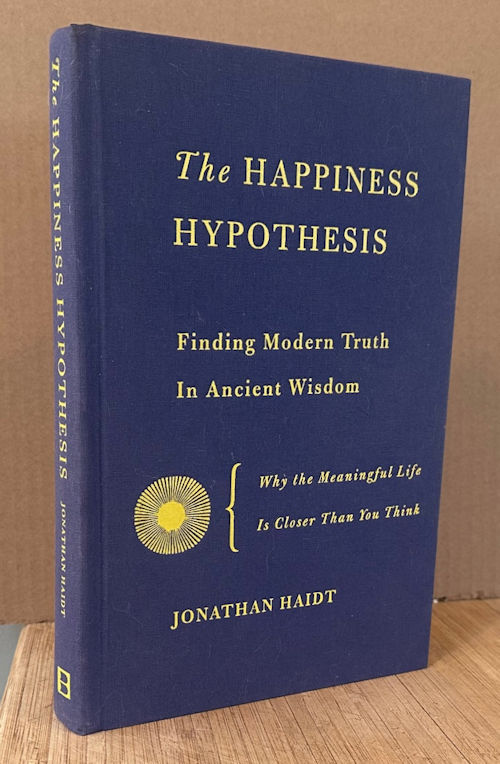Subtitled “Finding Modern Truth in Ancient Wisdom”
With second subtitle “Why the Meaningful Life is Closer than You Think”
(Basic Books, 2006, xiii + 297pp, including 54pp acknowledgements, notes, references, and index. Hardcover with no dust jacket.)
Here is a fascinating book that I didn’t get around to reading until the writer published later books, especially THE RIGHTEOUS MIND (review begins here), that I read first. This one seemed intriguing when I bought it in 2007, despite the whiff of self-helpiness about it, for presuming to compare “ancient wisdom” with modern-day scientific findings. This is exactly one of my core themes, even if in the guise of the discussion of base human nature with more modern enlightenment thinking. In fact, it’s almost exactly analogous to the theme of my book, which compares the assumptions by science fiction writers of how the world might be with the discoveries by actual science of how the world actually is.
So this book focuses on 10 great ideas, as discovered by the world’s civilizations, and then considers them in light of current scientific research. But they’re not just any 10 great ideas; they’re ideas, as the second subtitle says, about how to live, and how to be happy.
So then, the traditional takes on these 10 great ideas would reflect the biases of base human nature, would they not? Maybe not; maybe they’re deep insights by the wise men of history about things the ordinary person wouldn’t think about. But it’s hard to escape the limitations that ancients lived with in only experiencing the world with ordinary senses, which were insufficient to perceived how big the universe actually is, and how old.
I’ll post my full notes, polished up of course, but spread them out over three or four posts.
\
Here’s the author’s own summary of his ten ideas, from the introduction:
Author begins with how the human minds works. Two ancient truths:
1, The mind is divided into parts that sometimes conflict.
2, “Thinking makes it so”; why people’s minds have a bias toward seeing threats and engaging in needless worry.
Then, an account of our social lives. Two truths:
3, The golden rule; reciprocity.
4, We are all by nature hypocrites; but steps can be taken to reduce one’s self-righteousness.
Where does happiness come from?
5, Happiness comes from within, and from without; modern science will help us get the balance right.
What are the conditions for human growth and development?
6, What doesn’t kill you may still damage you for life; how to cope from adversity
7, How concepts of virtue and morality have changed and narrowed over the centuries…
Conclusion, questions of meaning.
8, People do perceive a vertical, spiritual dimension of human existence; how it works.
9, What is the meaning of life? Having a purpose.
10, The final version of the happiness hypothesis will not be revealed until later.
Since I read his later books first, it’s worth noting some themes that would recur, especially in THE CODDLING OF THE AMERICAN MIND, written with Greg Lukianoff (review here). In that book the authors discussed three “untruths”: What doesn’t kill you makes you weaker; Always trust your feelings; and Life is a battle between good people and bad people.
Each chapter opens with quotes from the ancients.
Ch1, The Divided Self
Quotes by St. Paul and Benjamin Franklin.
Author recalls riding a horse for the first time, and observing how it knew where to go, even if he didn’t. The mind is like the horse/man pair, or the rider and the elephant. [This was a key metaphor developed in THE RIGHTEOUS MIND.] Does the rider completely control the elephant? No. Different philosophers — Buddha, Plato, Freud — have had different takes on this, e.g. that people are rational and should be able to control their instinctive selves.
In fact, we know now that the mind is divided in four ways, the fourth being the most crucial.
1, Mind vs. body. Montaigne noted how different parts of the body seem to have minds of their own. How we have a ‘gut brain’ that operates our bodily functions, independent of the conscious mind.
2, Left vs. Right. Studies since the 1960s have shown that when the brain is split in half, e.g. to control seizures, each half of the brain has different perceptions and skills. Michael Gazzaniga studied this in the 90s [and wrote several books about it]. Thus, exposing different info to the two hemispheres can cause one part of the brain to be able to name things, but not the other.
3, New vs. Old. The brain has evolved over the millennia from the most basic—the older limbic [or ‘reptilian’] system, layered with successive stages, leading to the neocortex at the front, where reasoning takes place. The neocortex serves as a damper on the basic instincts expressed by the limbic system, e.g. sexual and aggressive impulses; tumors can damage the neocortex and leave the victim sociopathic. But the combination hasn’t reduced emotion; in fact it expanded emotionality. The orbitofrontal cortex corresponds to Freud’s ‘id’; without this people are at a loss to make decisions. Rationality depends on emotionality, p12-13.
4, Controlled vs. automatic. Models of the brain up to the 1990s were computer-based—operating systems running beneath the surface. A more refined take emerged: many of our responses are automatic, as when we are ‘primed’ by exposure to some idea that changes our response, e.g. being more aggressive or compassionate. OTOH controlled processing requires language. As with any new software, there are some bugs, while the automatic processes are highly refined.
The behaviorists were not quite right. The rider is an advisor or servant, but not a king, and not a slave.
Still, the two systems don’t always work well together. There are three quirks to be alert for:
1, Self-control. The famous marshmallow experiment; children who waited, who resisted temptation, grew up to be more successful.
2, Mental intrusions. Poe’s famous “imp”, understood as an effect of the conscious process making a decision—which the automatic process then monitors, making the conscious process think about what it decided not to think about. (“don’t think about elephants for the next 5 seconds”) Freud thought these were evidence of childhood traumas, etc.
3, The difficulty of winning an argument. Example of siblings who make love; if they took all precautions, is there a problem? Most people say yes. Why? They make up explanations. We rationalize or confabulate our intuitive judgments, and these can’t be changed through rational argument. The ‘rider’ becomes a lawyer, intent on justifying the intuitive judgments made by the elephant.
\
Ch2, Changing Your Mind
Key quotes by Aurelius and Buddha, p23. And Shakespeare—“There is nothing either good or bad but thinking makes it so” p31.
Why is the elephant such a pessimist?
The key idea of pop psychology is that the world is what you make of it; control your interpretations and you control the world. Most self-help books are on this subject. Dale Carnegie, Dr. Phil, et al.
The solution is to be above it all, to behave ‘philosophically.’ Long story about Boethius, condemned to execution, and how he thought about his final hours via Lady Philosophy.
Cognitive therapy is about such coming to terms. The problem with it is that most epiphanies fade with time. We must retrain the elephant.
There are three tools to do this.
1, The Like-O-Meter. A basic response of all animals is like or dislike, approach or withdraw. Humans have one too, that runs constantly, and with the discovery of ‘affective priming’ in the 1980s it became possible to measure this. [[ I note this key idea: psychology became a science once it became experimental, and once it could be measure things quantitatively ]] And so the elephant can be influenced by racial images, or even the names of other people.
2, Negativity Bias. Most psychology patients need either tightening or loosening. The elephant tends to see too many bad things. Why? It makes sense as a relative cost of survival. [[ this is the same as how perceptions perceive dangers easily: it’s better to detect a snake that’s not there, and survive, than to not detect the snake that is there, and die. ]] Examples p29. We can achieve a balance between these opposing system, and the balance point can be moved. But it’s the amygdala, in the deepest part of the brain, is the first to receive new information.
3, The Cortical Lottery. It turns out nature has a greater influence than once thought: example of identical twins, raised apart, whose tastes were amazingly similar, p32t. Different people have different takes on the world: some are inclined to see good in the world, others the opposite. This is a kind of ‘lottery’; it’s random, and you have to deal with what you get. It’s partly a balance between your approach or withdraw system. Example statements of different personality types, p34.
How to Change Your Mind. Three methods:
1, Meditation
2, Cognitive therapy
3, Prozac
Author discusses how he took Prozac for a while, and it worked, but its side-effect, the effect on his memory of facts and names, became too much of a burden. He wonders why some people think Prozac is a ‘cheat’.
All three of these are gradual methods for retraining your elephant, changing your outlook on the world.
\
Ch3, Reciprocity with a Vengeance
Quotes from Confucius and Rabbi Hillel
Philosophers offer ‘love’ or ‘reciprocity’ as the one word to live by.
Opening scene of The Godfather is great example.
Ultrasociality. Like flying, this seems contradictory considering the competition inherent in evolution. It depends on the genetics of kin altruism. (…) Also applies to bees, termites, mole rats. Ideas of the mafia ‘family’ key off the attraction of kinship.
You Scratch My Back, I’ll Scratch Yours. We have a reciprocity reflex; we respond to gestures of friendship. People have evolved to respond with a ‘tit for tat’ strategy — be nice at first, then do what the other does on the previous round. Animals do this with shared food. But this gives rise to cheaters; the response is that vengeance and gratitude have evolved to reinforce tit for tat. Example of a cooperation game, p51, involving unfair offers; again, anticipated by areas of the brain responding before conscious decisions are made.
You Stab His Back, I’ll Stab Yours. Gossip is another mechanism for enforcing sociality. Perhaps why we have such large heads; their size is reflective of social group size. Chimps live in groups of around 30; humans in groups of up to 150. Language evolved to talk about other people, and keep track of relationships and reputations. We’re motivated to tell other people things we find interesting. Studies show that gossip is mostly critical. And yet people are critical of gossipers (!). Yet gossip is about the value of other people for reciprocal relationships.
Use the Force, Luke. Of course these can be used against you: example of principles salespeople use against us. Free gifts, free samples, free mints. Concessions: start extreme, then compromise. (Bargain.) The same applies to relationships; balance give and take. We mimic those we like; it’s a kind of social glue.






